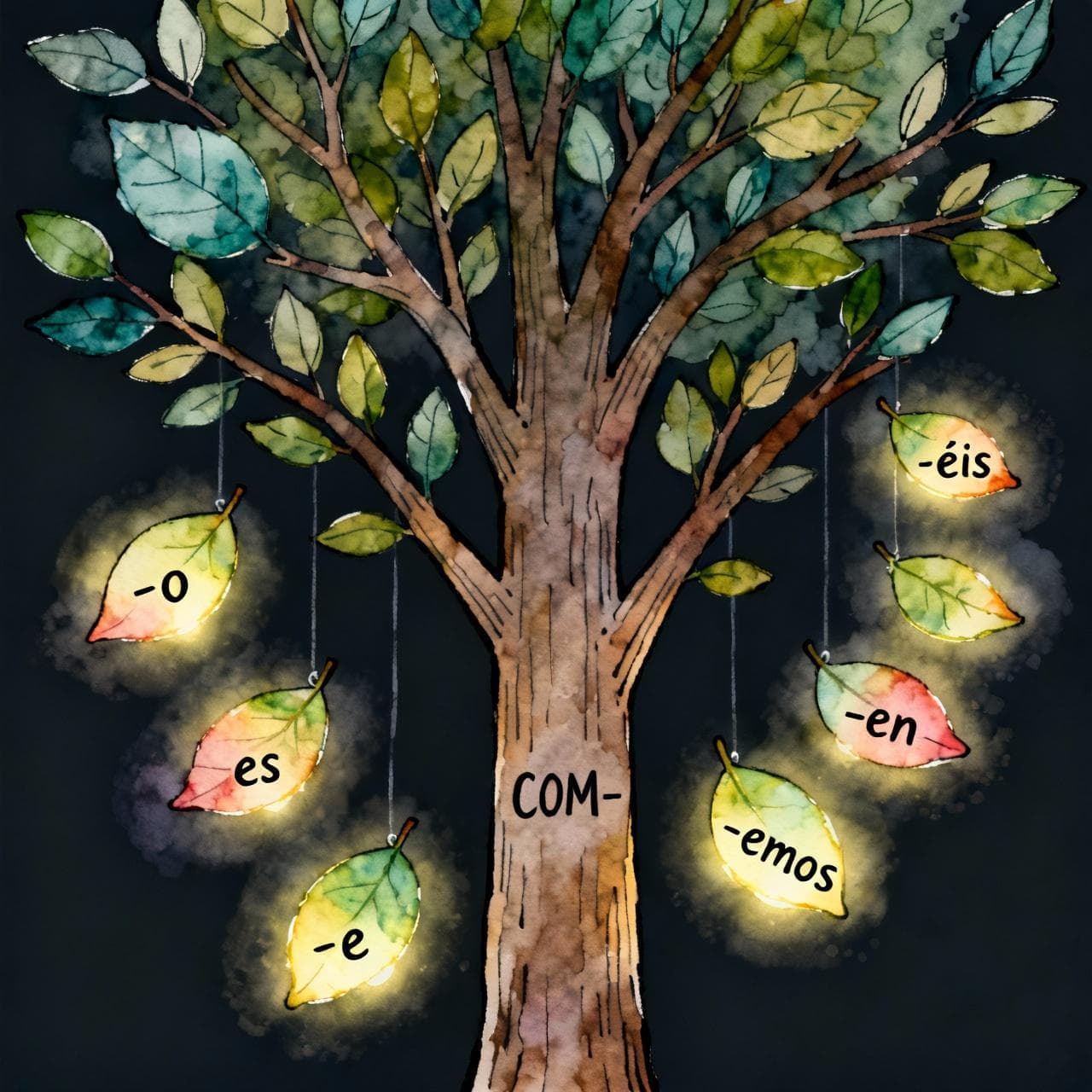Table of Contents
¡Hola, language learner! Welcome to your next big step in mastering Spanish. Today, we're tackling one of the most essential building blocks of the language. After mastering regular -ar verbs, you're ready for regular -er and -ir verbs in the present tense.
Don't let the word "conjugate" scare you. It's just a fancy way of saying we're changing the end of a verb to match who is doing the action. Think of it like saying "I run" versus "she runs" in English. You're already a conjugation pro!
By the end of this guide, you'll be able to confidently talk about what you and others eat, live, write, and so much more. Let's get started!

The Two-Step Recipe for Verb Success
For any regular -er or -ir verb, the process is the same. It’s a simple, two-step recipe:
- Find the Stem: Start with the verb in its original form, called the infinitive (like comerto eat or vivirto live). Drop the last two letters (-er or -ir) to find the verb’s “stem.”
- comer
→com- - vivir
→viv-
- comer
- Add the Ending: Attach the correct ending to the stem based on the subject pronoun (who is doing the action).
That’s it! The magic is in knowing which endings to use. Let’s break them down.
Part 1: Conquering Regular -ER Verbs
Let's start with -er verbs. These verbs talk about actions like eating, drinking, reading, and learning. The endings are your key to unlocking them.
Here are the endings for every regular -er verb in the present tense:
| Subject Pronoun | English | -ER Ending |
|---|---|---|
| Yo | I | -o |
| Tú | You (inf.) | -es |
| Él/Ella/Ud. | He/She/You (form.) | -e |
| Nosotros/as | We | -emos |
| Vosotros/as | You all (inf.) | -éis |
| Ellos/Ellas/Uds. | They/You all (form.) | -en |
Example: Comer (to eat)
Let's apply our two-step recipe to the verb comerto eat.
-
Find the Stem:
comer→com- -
Add the Endings:
- Yo como (I eat)
- Tú comes (You eat)
- Él come (He eats)
- Nosotros comemos (We eat)
- Vosotros coméis (You all eat)
- Ellos comen (They eat)
See how the stem com- stays the same, and only the ending changes? Let's try it with another verb, aprenderto learn.
- Yo aprendo español con Inklingo. (I learn Spanish with Inklingo.)
- ¿Tú aprendes rápido? (Do you learn quickly?)
Time to Practice!
Let's check your understanding. How would you say "We drink"? The verb is beberto drink.
Which is the correct form for 'We drink' (beber)?

Part 2: Investigating Regular -IR Verbs
Ready for some great news? If you've understood -er verbs, you're about 90% of the way to understanding -ir verbs! Their endings are almost identical.
Here are the endings for every regular -ir verb in the present tense:
| Subject Pronoun | English | -IR Ending |
|---|---|---|
| Yo | I | -o |
| Tú | You (inf.) | -es |
| Él/Ella/Ud. | He/She/You (form.) | -e |
| Nosotros/as | We | -imos |
| Vosotros/as | You all (inf.) | -ís |
| Ellos/Ellas/Uds. | They/You all (form.) | -en |
Spot the Difference!
Look closely! The only endings that are different from -er verbs are for nosotros and vosotros. Instead of -emos and -éis, we use -imos and -ís. Everything else is exactly the same!
Example: Vivir (to live)
Let's use our recipe for vivirto live.
- Find the Stem:
vivir→viv- - Add the Endings:
- Yo vivo (I live)
- Tú vives (You live)
- Él vive (He lives)
- Nosotros vivimos (We live)
- Vosotros vivís (You all live)
- Ellos viven (They live)
Let's see this key difference in action. Use the slider below to see how the "we" form changes between an -er and an -ir verb.
Drag the handle to compare
Let's build a sentence!
Now it's your turn to be the architect. Unscramble the words below to form a complete sentence. The verb is escribirto write.
Arrange the words to form a correct sentence:
Your Go-To Verb List

To help you practice, here’s a list of some common regular -er and -ir verbs you'll use all the time.
| Common -ER Verbs | Common -IR Verbs |
|---|---|
aprender (to learn) | abrir (to open) |
beber (to drink) | escribir (to write) |
comer (to eat) | vivir (to live) |
comprender (to understand) | decidir (to decide) |
correr (to run) | recibir (to receive) |
creer (to believe) | subir (to go up) |
leer (to read) | unir (to unite) |
vender (to sell) | describir (to describe) |
Many of these verbs relate to everyday food and meals, so they're incredibly useful to know.
You've Got This!
See? That wasn't so bad! You've just learned a fundamental skill in Spanish grammar. By remembering the two-step process (find the stem, add the ending) and the small difference between the -er and -ir verb charts, you've unlocked hundreds of new verbs.
The key now is to practice, practice, practice. Try making your own sentences with the verbs from the list above. The more you use them, the more natural they'll become.
Keep up the fantastic work, and continue your language journey right here in the InkLingo app!